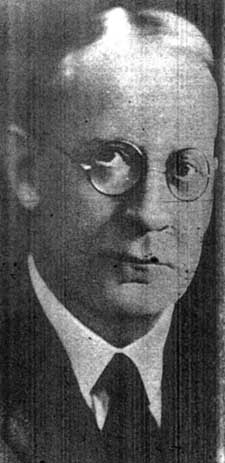
READ CHAPTER 1
GALLERY
WHO'S WHO
ATLAS
MYTHS DEBUNKED
FAMILY TREE
CONTACT THE AUTHOR
UPCOMING EVENTS
REVIEWS
CHICAGO HISTORY LINKS
READING SUGGESTIONS
BUY THIS BOOK
Luetgert witness back in the
news...
in 2003

In an October 17 article by William Mullen, the Chicago Tribune reported that the Field Museum in Chicago was returning the remains of about 150 Haida people to living members of the American Indian nation.
Some of these bones, which had been kept in wooden drawers for a century, had originally been collected in 1897 by George Dorsey, who was the Field Museum's assistant curator of anthropology at the time.
Dorsey brought back the bones after a trip to the West Coast in the summer of 1897. A couple of months later, he became the first anthropologist to offer expert testimony at a criminal trial. Dorsey was a key witness at the trial of Adolph Luetgert, where he testified that some small bone fragments found by police at Luetgert's sausage factory appeared to be human remains.
After Luetgert's first trial ended in a hung jury, Dorsey gave a lecture at the Field Museum on the Haida. According to the Tribune's recent article, Dorsey said, "They are a doomed race. Wars, smallpox, gross immorality, a change from old ways to new ways
— their fate is the common fate of the American, whether he sails the sea in the North, gallops over the plain in the West, or sleeps in his hammock in the forests of Brazil."The archives at the Field Museum contain some of the letters that Dorsey exchanged with Field Columbian Museum Director F.J.V. Skiff. On August 21, 1897, Skiff wrote a letter to Dorsey in California. The context of what Skiff was talking about is uncertain, but the letter hints at some controversies involving Dorsey's collection of Native American skeletons:
"In common, as I imagine, with every one else connected with the museum, I have read of your ship wreck, and of your arrest for desecrating graves. I knew that you were not on the Mexico, but many did not, and much regret was felt that the results of your expedition had been lost. With reference to the criminal proceedings against you, I observe that they were dismissed upon your assurance that you would return the skeletons to their silent tenements. I do not know how you kept both your word and the skeletons, but I have no doubt you did."
Dorsey testified at Luetgert's second trial on January 14 and 15, 1898.
On January 21 of that year, Dorsey wrote to Skiff, urging him to hire more people to assist with the museum's Native American collections: "The peculiar circumstances under which our North American Indians are placed makes it necessary that this (anthropological) work be done in the near future. I cannot take time to do all this field work and attend to the duties of the Department."
On January 28, while the second Luetgert trial continued, Dorsey and F.B. Melville of the Field Museum traveled to Oraibi, Arizona, to make plaster casts of Hopi Indians.
"Although we suffered greatly from the unusually cold weather, and from several mishaps generally incident to a wagon journey in Arizona, the expedition was very successful, and, as a matter of fact, we secured two more figures than we had anticipated," Dorsey wrote. "In addition to the casts, I secured a small collection, supplementing the one I made in August last year. This consisted chiefly of garments and paraphernalia necessary for the building of the Hopi groups. At this time I also passed four days in exploration of the ancient Hopi ruin of Homolobi, near Winslow. Here we secured over one hundred specimens of most interesting ceramics and a number of stone implements and fetiches (sic)."
In April, Dorsey made casts of nine "Esquimaux," who had been brought to Chicago by Captain Miner W. Bruce.
In an expedition leaving Chicago on May 12, 1898, Dorsey visited several Indian tribes in the American West, bringing back skeletons from some of the tribes. In a report, he noted that he was able to obtain only two skeletons from the Kootenay tribe: "These, it is believed, are the only Kootenay skeletons ever secured, owing to the strict watch kept by them over their burial grounds."
The report concluded (in a passage that was typed but crossed out for some reason): "It is the earnest desire of the Curator of Anthropology that other expeditions be made in the near future as every year witnesses great change in methods of life of the Aborigines of that region. Many formerly extensive and interesting tribes and nations have either entirely disappeared or have undergone changes so great as to be of little interest at the present time to anthropology."
Dorsey and other scientists of his time believed they were preserving remnants of a dying people. Field Museum archeologist Jonathan Haas told the Tribune that scientists wanted to use the skeletons to record the "typical" physical traits of each tribe. The theory that different Indian nations are different "races" has since been discredited.
"This type of collection would be totally unacceptable today in any part of the world," Haas told the Tribune. "You don't disturb remains of people who have direct living descendants right there."
The remains of the Haida collected by Dorsey and other Field Museum employees were finally returned to the tribe's villages on British Columbia's Queen Charlotte Islands in October 2003.
Coincidentally, the return of the bones came at about the same time as the publication of Alchemy of Bones, which prominently features George Dorsey.
Read more about George Dorsey.
Photo of Dorsey: True Detective Mysteries